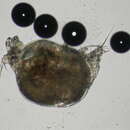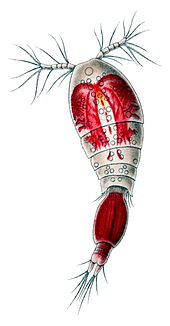pt-BR
nomes no trilho de navegação


Die Poecilostomatoida bilden eine Ordnung der Ruderfußkrebse (Copepoda). Die meisten Arten leben auf der Oberfläche von Salzwasserfischen, Weichtieren und Stachelhäutern. Die Ordnung Poecilostomatoida wird jedoch von manchen Autoren inzwischen den Cyclopoida untergeordnet.[1] In der Bezeichnung steckt das griechische Wort "ποικίλος", "poikílos", welches gefleckt oder ausgeschmückt bedeutet. In biologischen Namen bedeutet es auch variabel, vielgestaltig. Der zweite Teil des Wortes leitet sich vom griechischen "στόμα", "stóma" für Mundöffnung ab. Poecilostomatoida bedeutet also Lebewesen mit vielgestaltigen Mundwerkzeugen.
Ein gemeinsames Merkmal der Arten dieser Ordnung ist das Verhalten bei der Paarung. Anders als bei den übrigen Ruderfußkrebsen werden die Weibchen der Poecilostomatoida von den Männchen mit den Maxillipeden ergriffen, nicht mit den Antennulae. Das führte im Laufe der Stammesgeschichte zu einem Geschlechtsdimorphismus in der Ausformung der Maxillipeden.[2]
Die weitere Klassifikation dieser Krebstiere wurde aufgrund der Struktur ihrer Mundwerkzeuge vorgenommen. Bei den Poecilostomatoida haben die Mandibeln eine transversale Spalte, die teilweise durch ein überhängendes Labrum bedeckt wird, die einer Oberlippe ähnelt. Obwohl die Form der Mandibel bei den Poecilostomatoida stark variiert, kann sie doch allgemein als sichelförmlich beschrieben werden.[3][4]
Die Antennen sind häufig in der Größe stark reduziert und teilweise zu kleinen Haken oder Klauen modifiziert, die dazu dienen, die Krebstiere an ihrem Wirt festzuhalten.[3][4]
Wie bei allen Krebstieren gibt es eine Reihe von Larvenstadien, die durch Häutungen getrennt sind und an deren Ende die Erwachsenenform steht, die sich nicht mehr häutet. Dabei unterscheiden sich die Larvenstadien erheblich von der Form erwachsener Poecilostomatoida. Die Embryonen werden vom Muttertier in einzelnen oder paarigen Säckchen, die am ersten Bauchring (1. Thorakalsegment) befestigt sind, transportiert. Auf dem Bild links sind die blaugefärbten Säckchen gut zu erkennen.[5][6]
Die meisten Poecilostomatoida leben als Ektoparasiten auf Meeresfischen, Weichtieren oder Stachelhäutern. Meist halten sie sich an der Außenhaut des Wirtes fest oder leben in Mundhöhle oder Schlund. Einige befallen auch die Kiemen der Wirtstiere.[3][4][7][8] Nur eine Familie der Poecilostomatoida lebt endoparasitisch im Körper des Wirts.[3][4] Einige Poecilostomatoida wurden auch an ungewöhnlichen Orten gefunden, zum Beispiel in Strandseen, bei Tiefseeschloten und kalten Tiefseequellen. Einzelne Arten haben auch das Süßwasser erobert und befallen die darin lebenden Fische.[3][4]
Die Ordnung umfasst mehr als 60 Familien[9]:
Die Poecilostomatoida bilden eine Ordnung der Ruderfußkrebse (Copepoda). Die meisten Arten leben auf der Oberfläche von Salzwasserfischen, Weichtieren und Stachelhäutern. Die Ordnung Poecilostomatoida wird jedoch von manchen Autoren inzwischen den Cyclopoida untergeordnet. In der Bezeichnung steckt das griechische Wort "ποικίλος", "poikílos", welches gefleckt oder ausgeschmückt bedeutet. In biologischen Namen bedeutet es auch variabel, vielgestaltig. Der zweite Teil des Wortes leitet sich vom griechischen "στόμα", "stóma" für Mundöffnung ab. Poecilostomatoida bedeutet also Lebewesen mit vielgestaltigen Mundwerkzeugen.
Poecilostomatoida are an suborder of copepods. Although it was previously considered a separate order,[1][2] recent research showed it to be nested within the Cyclopoida[3]
The classification of these copepods has been established on the basis of the structure of the mouth. In poecilostomatoids the mouth is represented by a transverse slit, partially covered by the overhanging labrum which resembles an upper lip. Although there is variability in the form of the mandible among poecilostomatoids, it can be generalized as being falcate (sickle-shaped).[1][2]
The antennules are frequently reduced in size and the antennae modified to terminate in small hooks or claws that are used in attachment to host organisms.[1][2]
As with many crustaceans, larval development is metamorphic with immature forms differing greatly from those of adults. Embryos are carried in paired or single sacs attached to first abdominal somite (as seen in the illustration of the female Sapphirina darwinii above right).[4][5]
Most poecilostomatoid copepods are ectoparasites of saltwater fish or invertebrates (including among the latter mollusks and echinoderms). They usually attach to the external surface of the host, in the throat-mouth cavity, or the gills.[1][2][6][7] One family of poecilostomatoid copepods, however, have evolved an endoparasitic mode of life and live deep within their hosts' bodies rather than merely attaching themselves to exterior and semi-exterior surface tissue.[1][2]
In addition to typical marine environments, poecilostomatoid copepods may be found in such very particular habitats as anchialine caves and deep sea vents (both hydrothermal vents and cold seeps). Here, many primitive associated copepods belonging to the Poecilostomatoida and Siphonostomatoida and have been found.[7] Representatives of one Poecilostomatoida family have successfully made the transition to freshwater habitats and host animals therein.[1][2]

There are over sixty families currently recognized within the group:[8]
Poecilostomatoida are an suborder of copepods. Although it was previously considered a separate order, recent research showed it to be nested within the Cyclopoida
Les Poecilostomatoida sont un ordre de crustacés copépodes.
Poecilostomatoida è un sottordine di crostacei facenti parte dell'ordine dei Cyclopoida.
Sono prevalentemente parassiti di pesci, che infestano insinuandosi nel derma, nelle branchie e nella lingua. Sono dotati di seconde antenne modificate con uncini.